FELM4026 Financial and Economic Literacy for Managers Spring 2019
VerifiedAdded on 2023/04/08
|19
|3114
|244
Report
AI Summary
This report delves into financial and economic literacy for management, covering key concepts such as consumer sovereignty, profit maximization, and their interplay in competitive markets. It contrasts wealth maximization with profit maximization, highlighting the superiority of the former for sustainable growth. The report also examines the impact of fiscal, monetary, and supply-side policies on economic prosperity, including decreasing tax burdens, labor market flexibility, and privatization. Furthermore, it analyzes trade and labor union relationships and environmental policies. The document is a comprehensive overview of the factors influencing financial and economic decision-making in a business context.
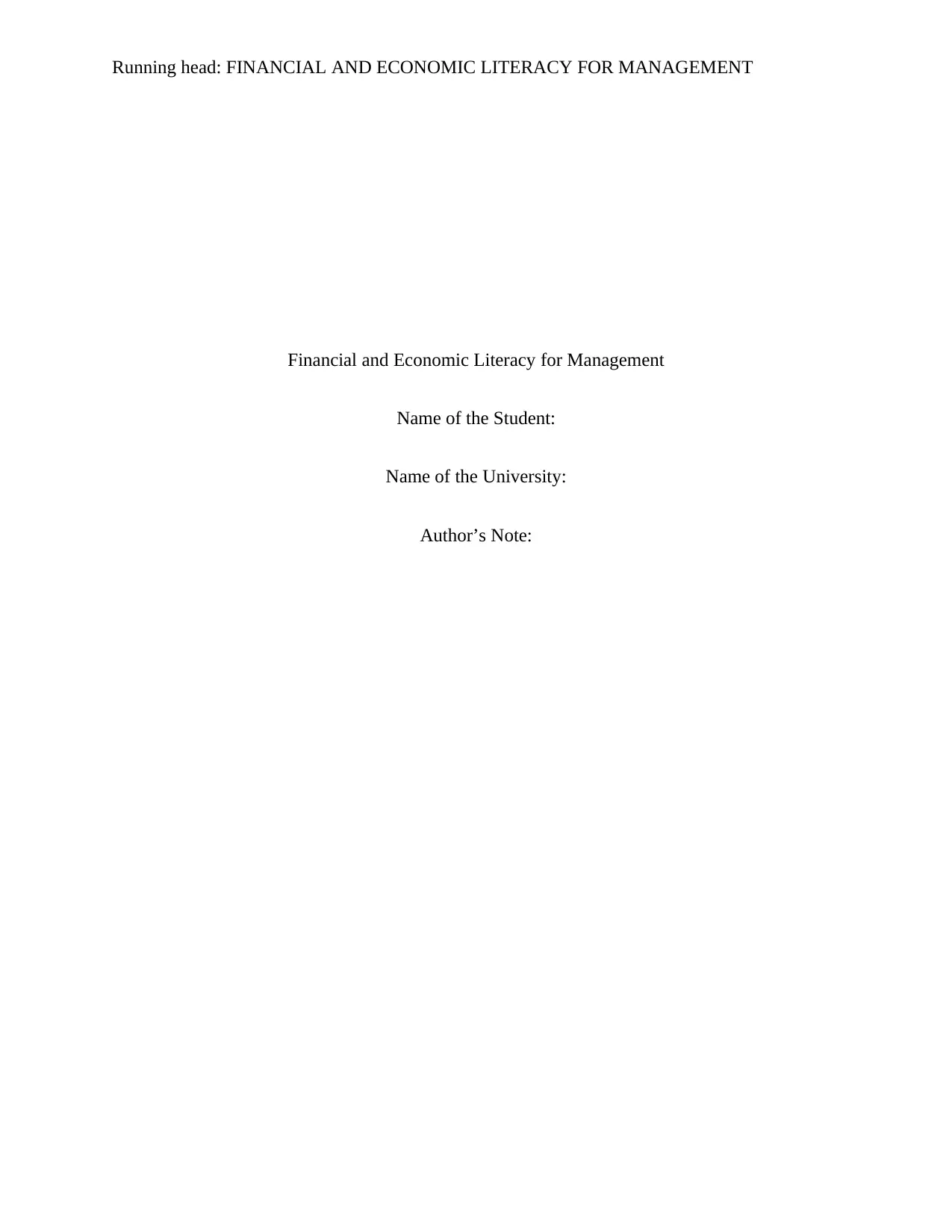
Running head: FINANCIAL AND ECONOMIC LITERACY FOR MANAGEMENT
Financial and Economic Literacy for Management
Name of the Student:
Name of the University:
Author’s Note:
Financial and Economic Literacy for Management
Name of the Student:
Name of the University:
Author’s Note:
Paraphrase This Document
Need a fresh take? Get an instant paraphrase of this document with our AI Paraphraser
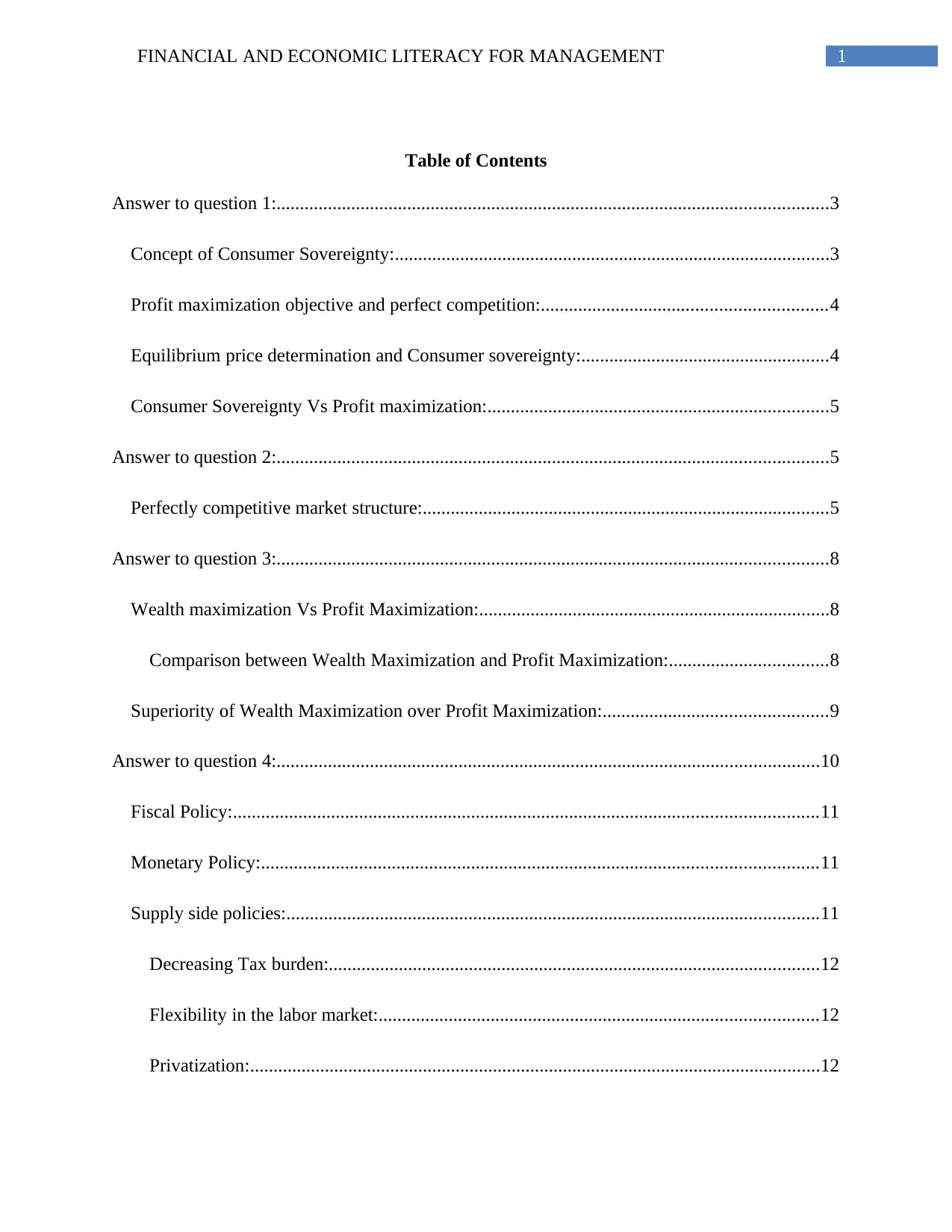
1FINANCIAL AND ECONOMIC LITERACY FOR MANAGEMENT
Table of Contents
Answer to question 1:......................................................................................................................3
Concept of Consumer Sovereignty:.............................................................................................3
Profit maximization objective and perfect competition:.............................................................4
Equilibrium price determination and Consumer sovereignty:.....................................................4
Consumer Sovereignty Vs Profit maximization:.........................................................................5
Answer to question 2:......................................................................................................................5
Perfectly competitive market structure:.......................................................................................5
Answer to question 3:......................................................................................................................8
Wealth maximization Vs Profit Maximization:...........................................................................8
Comparison between Wealth Maximization and Profit Maximization:..................................8
Superiority of Wealth Maximization over Profit Maximization:................................................9
Answer to question 4:....................................................................................................................10
Fiscal Policy:.............................................................................................................................11
Monetary Policy:.......................................................................................................................11
Supply side policies:..................................................................................................................11
Decreasing Tax burden:.........................................................................................................12
Flexibility in the labor market:..............................................................................................12
Privatization:..........................................................................................................................12
Table of Contents
Answer to question 1:......................................................................................................................3
Concept of Consumer Sovereignty:.............................................................................................3
Profit maximization objective and perfect competition:.............................................................4
Equilibrium price determination and Consumer sovereignty:.....................................................4
Consumer Sovereignty Vs Profit maximization:.........................................................................5
Answer to question 2:......................................................................................................................5
Perfectly competitive market structure:.......................................................................................5
Answer to question 3:......................................................................................................................8
Wealth maximization Vs Profit Maximization:...........................................................................8
Comparison between Wealth Maximization and Profit Maximization:..................................8
Superiority of Wealth Maximization over Profit Maximization:................................................9
Answer to question 4:....................................................................................................................10
Fiscal Policy:.............................................................................................................................11
Monetary Policy:.......................................................................................................................11
Supply side policies:..................................................................................................................11
Decreasing Tax burden:.........................................................................................................12
Flexibility in the labor market:..............................................................................................12
Privatization:..........................................................................................................................12
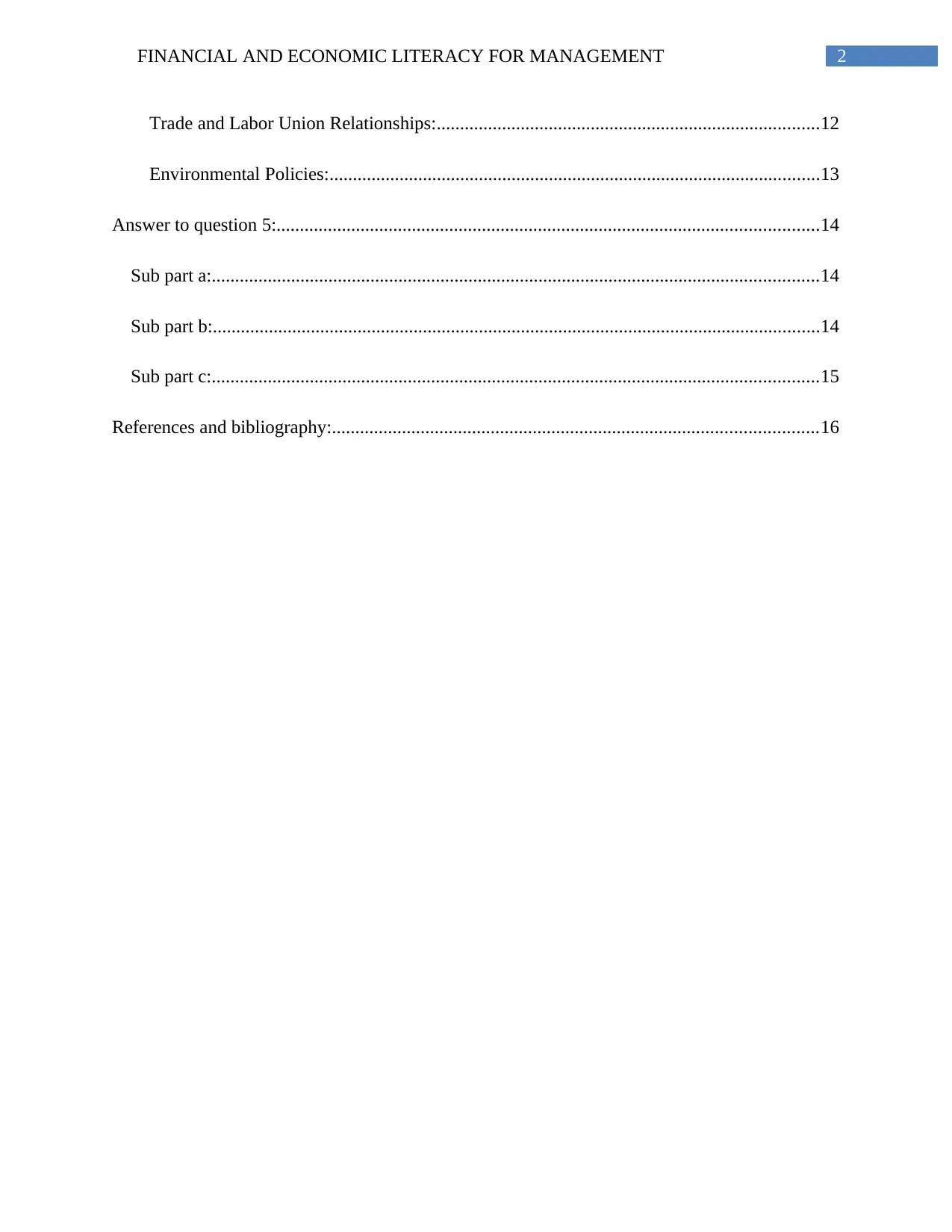
2FINANCIAL AND ECONOMIC LITERACY FOR MANAGEMENT
Trade and Labor Union Relationships:..................................................................................12
Environmental Policies:.........................................................................................................13
Answer to question 5:....................................................................................................................14
Sub part a:..................................................................................................................................14
Sub part b:..................................................................................................................................14
Sub part c:..................................................................................................................................15
References and bibliography:........................................................................................................16
Trade and Labor Union Relationships:..................................................................................12
Environmental Policies:.........................................................................................................13
Answer to question 5:....................................................................................................................14
Sub part a:..................................................................................................................................14
Sub part b:..................................................................................................................................14
Sub part c:..................................................................................................................................15
References and bibliography:........................................................................................................16
⊘ This is a preview!⊘
Do you want full access?
Subscribe today to unlock all pages.

Trusted by 1+ million students worldwide
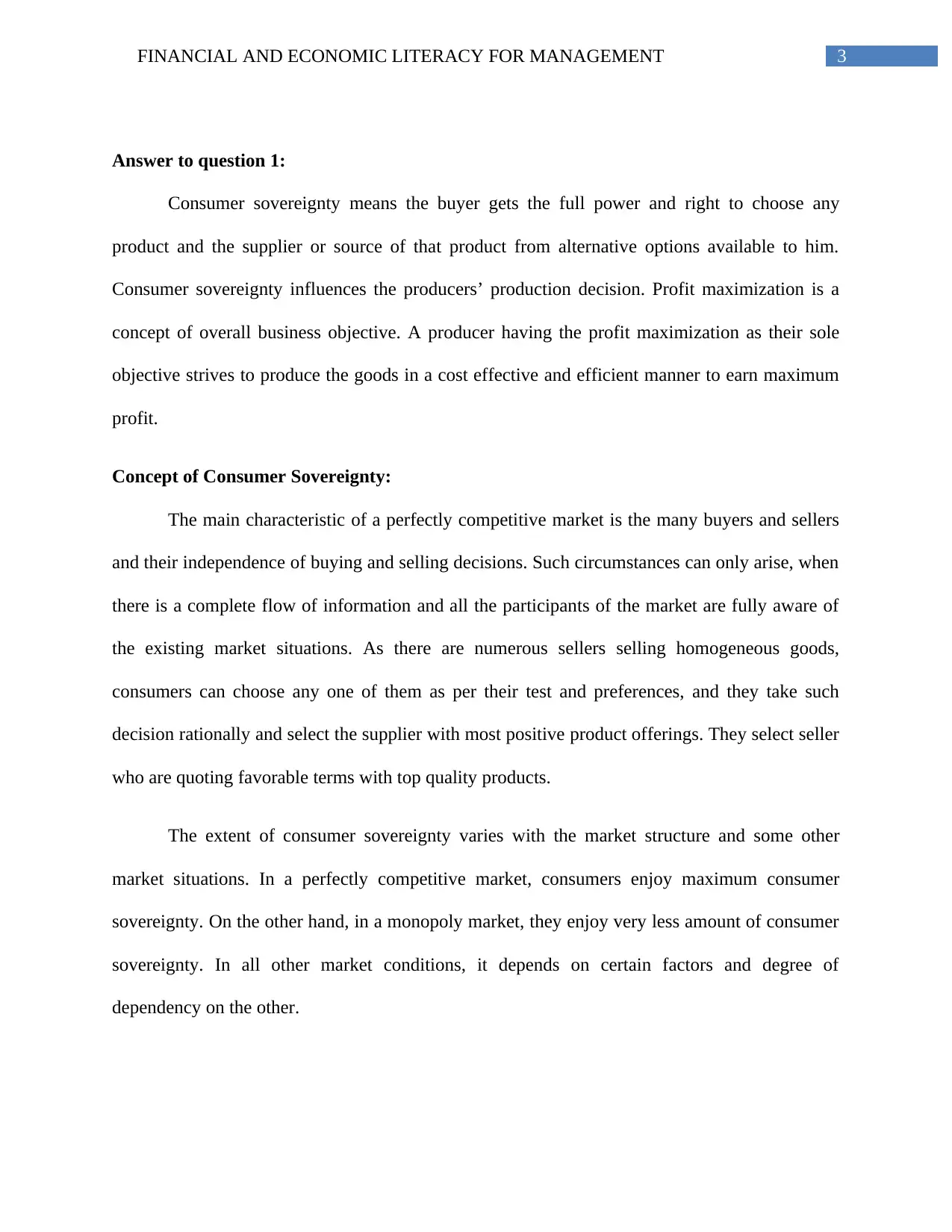
3FINANCIAL AND ECONOMIC LITERACY FOR MANAGEMENT
Answer to question 1:
Consumer sovereignty means the buyer gets the full power and right to choose any
product and the supplier or source of that product from alternative options available to him.
Consumer sovereignty influences the producers’ production decision. Profit maximization is a
concept of overall business objective. A producer having the profit maximization as their sole
objective strives to produce the goods in a cost effective and efficient manner to earn maximum
profit.
Concept of Consumer Sovereignty:
The main characteristic of a perfectly competitive market is the many buyers and sellers
and their independence of buying and selling decisions. Such circumstances can only arise, when
there is a complete flow of information and all the participants of the market are fully aware of
the existing market situations. As there are numerous sellers selling homogeneous goods,
consumers can choose any one of them as per their test and preferences, and they take such
decision rationally and select the supplier with most positive product offerings. They select seller
who are quoting favorable terms with top quality products.
The extent of consumer sovereignty varies with the market structure and some other
market situations. In a perfectly competitive market, consumers enjoy maximum consumer
sovereignty. On the other hand, in a monopoly market, they enjoy very less amount of consumer
sovereignty. In all other market conditions, it depends on certain factors and degree of
dependency on the other.
Answer to question 1:
Consumer sovereignty means the buyer gets the full power and right to choose any
product and the supplier or source of that product from alternative options available to him.
Consumer sovereignty influences the producers’ production decision. Profit maximization is a
concept of overall business objective. A producer having the profit maximization as their sole
objective strives to produce the goods in a cost effective and efficient manner to earn maximum
profit.
Concept of Consumer Sovereignty:
The main characteristic of a perfectly competitive market is the many buyers and sellers
and their independence of buying and selling decisions. Such circumstances can only arise, when
there is a complete flow of information and all the participants of the market are fully aware of
the existing market situations. As there are numerous sellers selling homogeneous goods,
consumers can choose any one of them as per their test and preferences, and they take such
decision rationally and select the supplier with most positive product offerings. They select seller
who are quoting favorable terms with top quality products.
The extent of consumer sovereignty varies with the market structure and some other
market situations. In a perfectly competitive market, consumers enjoy maximum consumer
sovereignty. On the other hand, in a monopoly market, they enjoy very less amount of consumer
sovereignty. In all other market conditions, it depends on certain factors and degree of
dependency on the other.
Paraphrase This Document
Need a fresh take? Get an instant paraphrase of this document with our AI Paraphraser
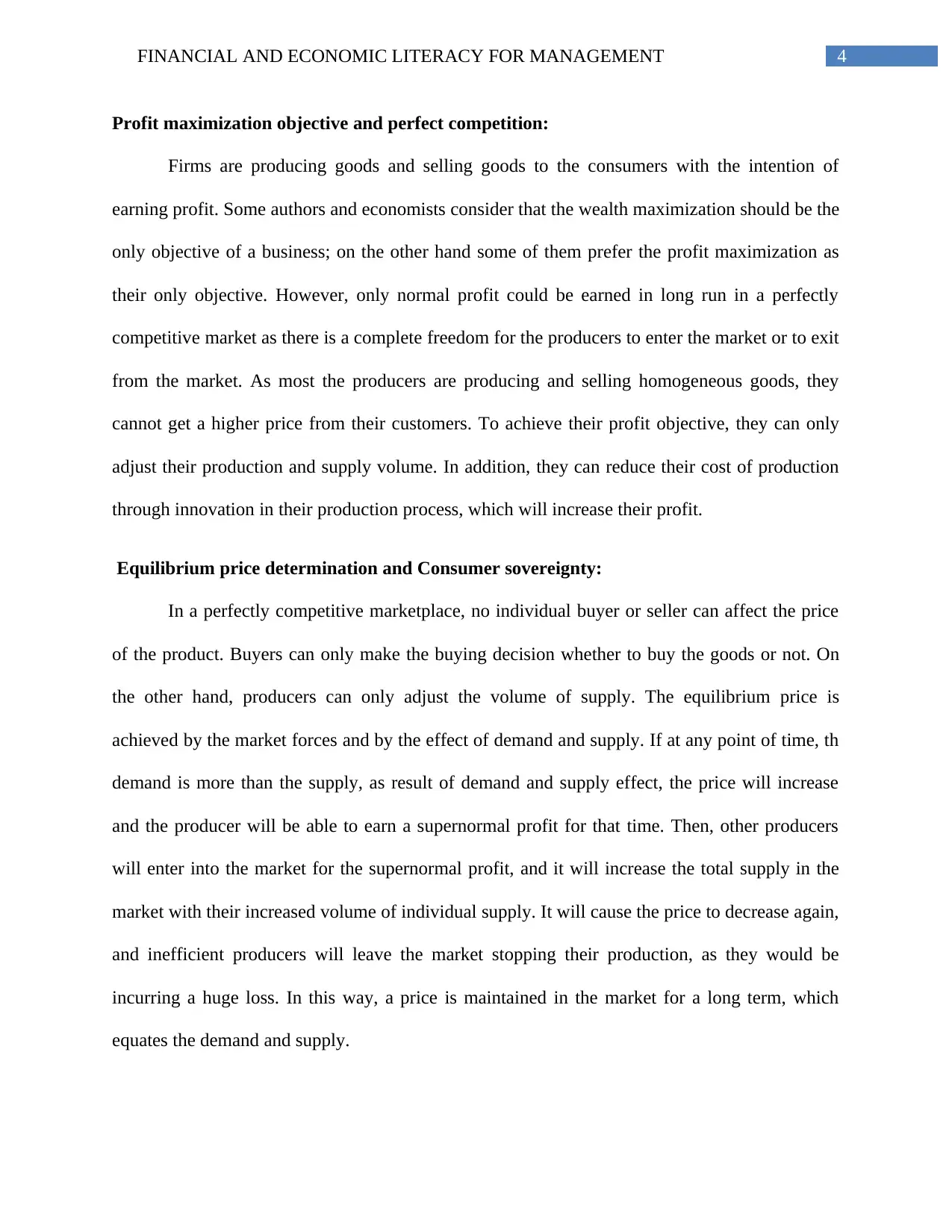
4FINANCIAL AND ECONOMIC LITERACY FOR MANAGEMENT
Profit maximization objective and perfect competition:
Firms are producing goods and selling goods to the consumers with the intention of
earning profit. Some authors and economists consider that the wealth maximization should be the
only objective of a business; on the other hand some of them prefer the profit maximization as
their only objective. However, only normal profit could be earned in long run in a perfectly
competitive market as there is a complete freedom for the producers to enter the market or to exit
from the market. As most the producers are producing and selling homogeneous goods, they
cannot get a higher price from their customers. To achieve their profit objective, they can only
adjust their production and supply volume. In addition, they can reduce their cost of production
through innovation in their production process, which will increase their profit.
Equilibrium price determination and Consumer sovereignty:
In a perfectly competitive marketplace, no individual buyer or seller can affect the price
of the product. Buyers can only make the buying decision whether to buy the goods or not. On
the other hand, producers can only adjust the volume of supply. The equilibrium price is
achieved by the market forces and by the effect of demand and supply. If at any point of time, th
demand is more than the supply, as result of demand and supply effect, the price will increase
and the producer will be able to earn a supernormal profit for that time. Then, other producers
will enter into the market for the supernormal profit, and it will increase the total supply in the
market with their increased volume of individual supply. It will cause the price to decrease again,
and inefficient producers will leave the market stopping their production, as they would be
incurring a huge loss. In this way, a price is maintained in the market for a long term, which
equates the demand and supply.
Profit maximization objective and perfect competition:
Firms are producing goods and selling goods to the consumers with the intention of
earning profit. Some authors and economists consider that the wealth maximization should be the
only objective of a business; on the other hand some of them prefer the profit maximization as
their only objective. However, only normal profit could be earned in long run in a perfectly
competitive market as there is a complete freedom for the producers to enter the market or to exit
from the market. As most the producers are producing and selling homogeneous goods, they
cannot get a higher price from their customers. To achieve their profit objective, they can only
adjust their production and supply volume. In addition, they can reduce their cost of production
through innovation in their production process, which will increase their profit.
Equilibrium price determination and Consumer sovereignty:
In a perfectly competitive marketplace, no individual buyer or seller can affect the price
of the product. Buyers can only make the buying decision whether to buy the goods or not. On
the other hand, producers can only adjust the volume of supply. The equilibrium price is
achieved by the market forces and by the effect of demand and supply. If at any point of time, th
demand is more than the supply, as result of demand and supply effect, the price will increase
and the producer will be able to earn a supernormal profit for that time. Then, other producers
will enter into the market for the supernormal profit, and it will increase the total supply in the
market with their increased volume of individual supply. It will cause the price to decrease again,
and inefficient producers will leave the market stopping their production, as they would be
incurring a huge loss. In this way, a price is maintained in the market for a long term, which
equates the demand and supply.
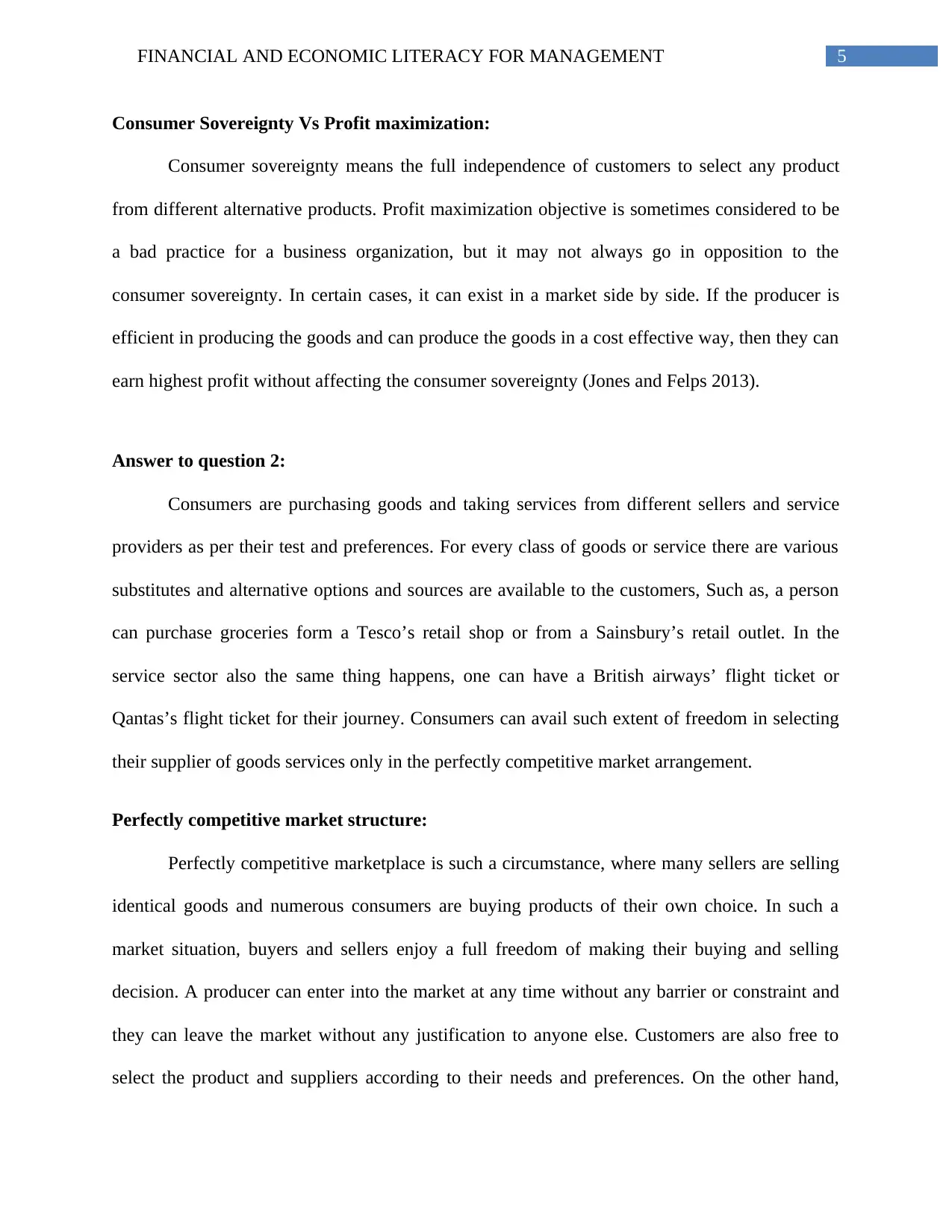
5FINANCIAL AND ECONOMIC LITERACY FOR MANAGEMENT
Consumer Sovereignty Vs Profit maximization:
Consumer sovereignty means the full independence of customers to select any product
from different alternative products. Profit maximization objective is sometimes considered to be
a bad practice for a business organization, but it may not always go in opposition to the
consumer sovereignty. In certain cases, it can exist in a market side by side. If the producer is
efficient in producing the goods and can produce the goods in a cost effective way, then they can
earn highest profit without affecting the consumer sovereignty (Jones and Felps 2013).
Answer to question 2:
Consumers are purchasing goods and taking services from different sellers and service
providers as per their test and preferences. For every class of goods or service there are various
substitutes and alternative options and sources are available to the customers, Such as, a person
can purchase groceries form a Tesco’s retail shop or from a Sainsbury’s retail outlet. In the
service sector also the same thing happens, one can have a British airways’ flight ticket or
Qantas’s flight ticket for their journey. Consumers can avail such extent of freedom in selecting
their supplier of goods services only in the perfectly competitive market arrangement.
Perfectly competitive market structure:
Perfectly competitive marketplace is such a circumstance, where many sellers are selling
identical goods and numerous consumers are buying products of their own choice. In such a
market situation, buyers and sellers enjoy a full freedom of making their buying and selling
decision. A producer can enter into the market at any time without any barrier or constraint and
they can leave the market without any justification to anyone else. Customers are also free to
select the product and suppliers according to their needs and preferences. On the other hand,
Consumer Sovereignty Vs Profit maximization:
Consumer sovereignty means the full independence of customers to select any product
from different alternative products. Profit maximization objective is sometimes considered to be
a bad practice for a business organization, but it may not always go in opposition to the
consumer sovereignty. In certain cases, it can exist in a market side by side. If the producer is
efficient in producing the goods and can produce the goods in a cost effective way, then they can
earn highest profit without affecting the consumer sovereignty (Jones and Felps 2013).
Answer to question 2:
Consumers are purchasing goods and taking services from different sellers and service
providers as per their test and preferences. For every class of goods or service there are various
substitutes and alternative options and sources are available to the customers, Such as, a person
can purchase groceries form a Tesco’s retail shop or from a Sainsbury’s retail outlet. In the
service sector also the same thing happens, one can have a British airways’ flight ticket or
Qantas’s flight ticket for their journey. Consumers can avail such extent of freedom in selecting
their supplier of goods services only in the perfectly competitive market arrangement.
Perfectly competitive market structure:
Perfectly competitive marketplace is such a circumstance, where many sellers are selling
identical goods and numerous consumers are buying products of their own choice. In such a
market situation, buyers and sellers enjoy a full freedom of making their buying and selling
decision. A producer can enter into the market at any time without any barrier or constraint and
they can leave the market without any justification to anyone else. Customers are also free to
select the product and suppliers according to their needs and preferences. On the other hand,
⊘ This is a preview!⊘
Do you want full access?
Subscribe today to unlock all pages.

Trusted by 1+ million students worldwide
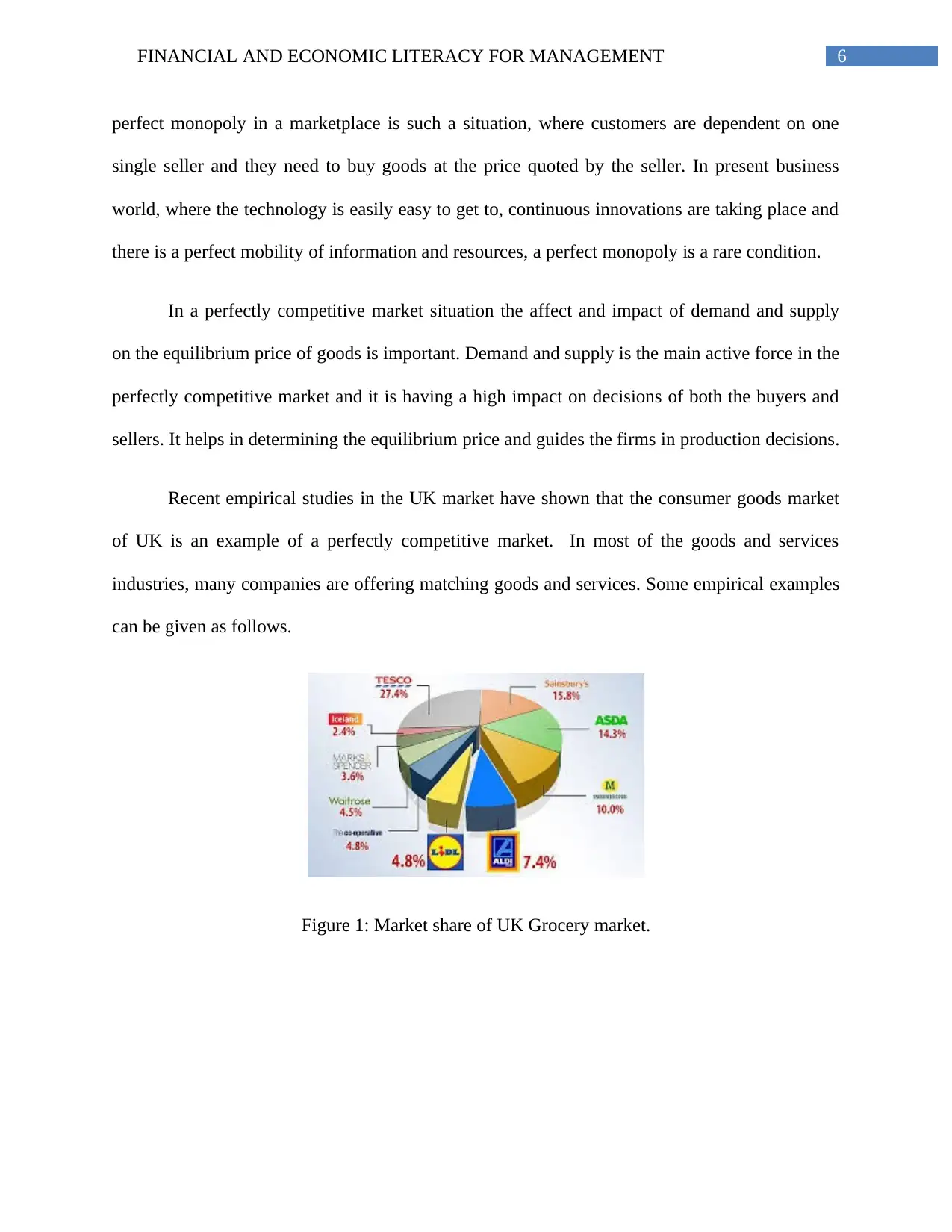
6FINANCIAL AND ECONOMIC LITERACY FOR MANAGEMENT
perfect monopoly in a marketplace is such a situation, where customers are dependent on one
single seller and they need to buy goods at the price quoted by the seller. In present business
world, where the technology is easily easy to get to, continuous innovations are taking place and
there is a perfect mobility of information and resources, a perfect monopoly is a rare condition.
In a perfectly competitive market situation the affect and impact of demand and supply
on the equilibrium price of goods is important. Demand and supply is the main active force in the
perfectly competitive market and it is having a high impact on decisions of both the buyers and
sellers. It helps in determining the equilibrium price and guides the firms in production decisions.
Recent empirical studies in the UK market have shown that the consumer goods market
of UK is an example of a perfectly competitive market. In most of the goods and services
industries, many companies are offering matching goods and services. Some empirical examples
can be given as follows.
Figure 1: Market share of UK Grocery market.
perfect monopoly in a marketplace is such a situation, where customers are dependent on one
single seller and they need to buy goods at the price quoted by the seller. In present business
world, where the technology is easily easy to get to, continuous innovations are taking place and
there is a perfect mobility of information and resources, a perfect monopoly is a rare condition.
In a perfectly competitive market situation the affect and impact of demand and supply
on the equilibrium price of goods is important. Demand and supply is the main active force in the
perfectly competitive market and it is having a high impact on decisions of both the buyers and
sellers. It helps in determining the equilibrium price and guides the firms in production decisions.
Recent empirical studies in the UK market have shown that the consumer goods market
of UK is an example of a perfectly competitive market. In most of the goods and services
industries, many companies are offering matching goods and services. Some empirical examples
can be given as follows.
Figure 1: Market share of UK Grocery market.
Paraphrase This Document
Need a fresh take? Get an instant paraphrase of this document with our AI Paraphraser
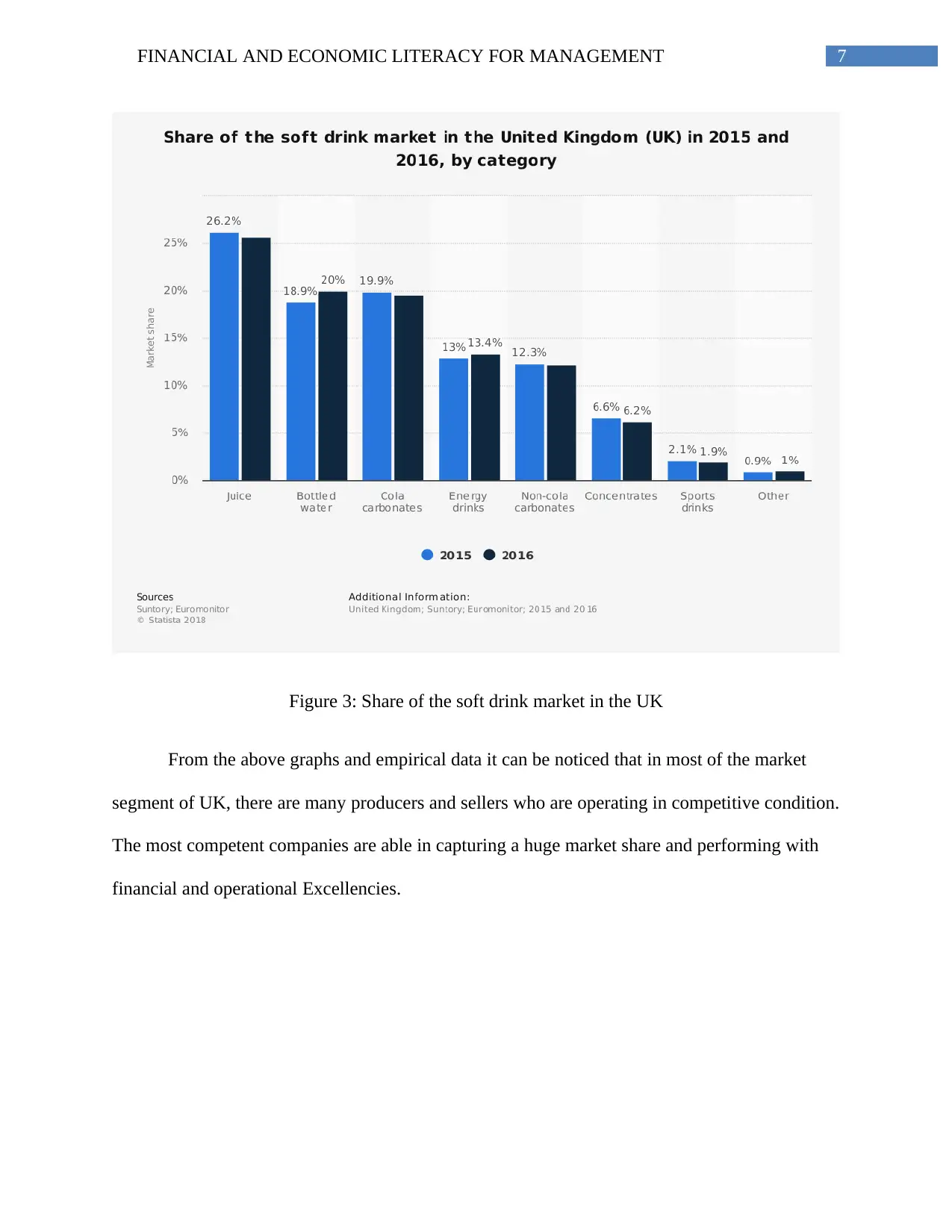
7FINANCIAL AND ECONOMIC LITERACY FOR MANAGEMENT
Figure 3: Share of the soft drink market in the UK
From the above graphs and empirical data it can be noticed that in most of the market
segment of UK, there are many producers and sellers who are operating in competitive condition.
The most competent companies are able in capturing a huge market share and performing with
financial and operational Excellencies.
Figure 3: Share of the soft drink market in the UK
From the above graphs and empirical data it can be noticed that in most of the market
segment of UK, there are many producers and sellers who are operating in competitive condition.
The most competent companies are able in capturing a huge market share and performing with
financial and operational Excellencies.
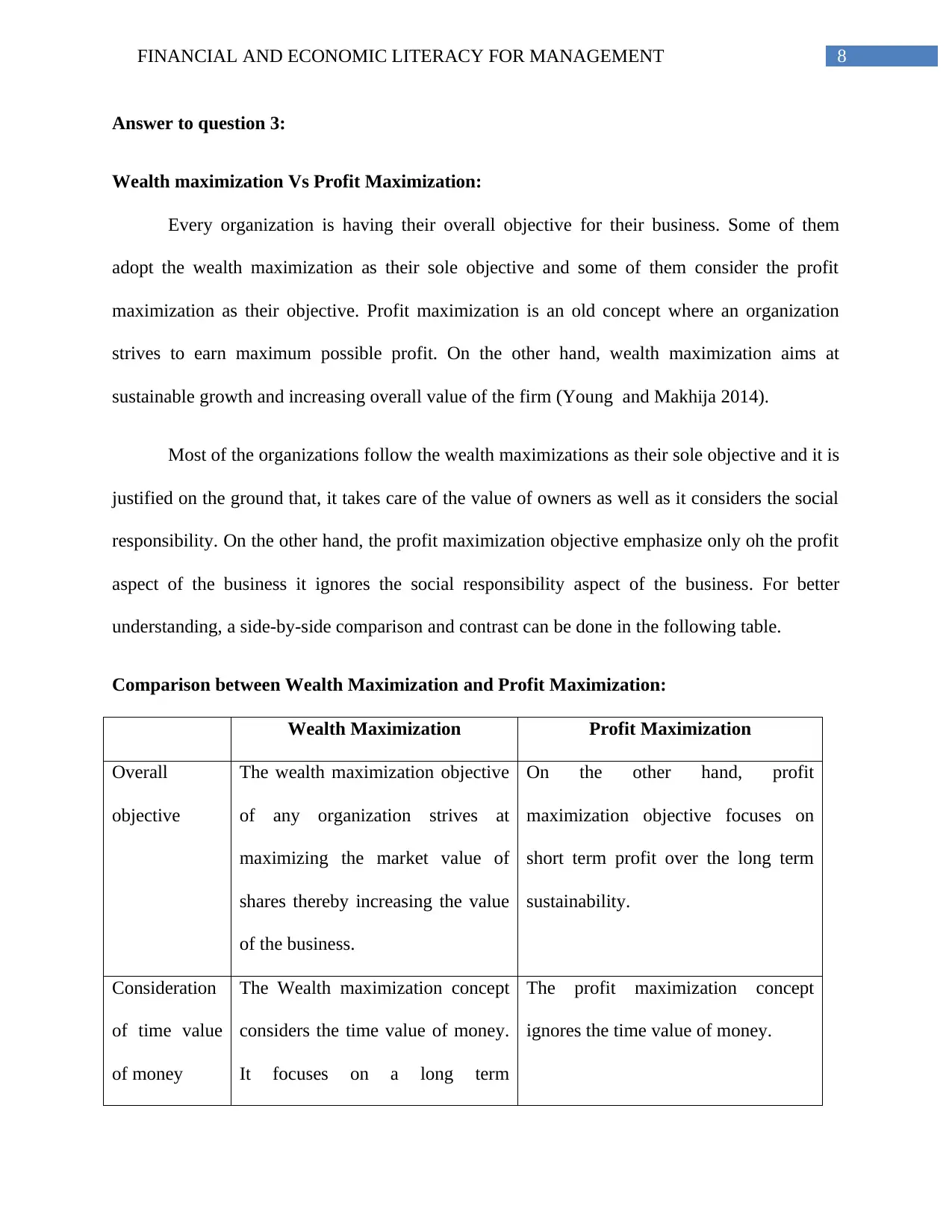
8FINANCIAL AND ECONOMIC LITERACY FOR MANAGEMENT
Answer to question 3:
Wealth maximization Vs Profit Maximization:
Every organization is having their overall objective for their business. Some of them
adopt the wealth maximization as their sole objective and some of them consider the profit
maximization as their objective. Profit maximization is an old concept where an organization
strives to earn maximum possible profit. On the other hand, wealth maximization aims at
sustainable growth and increasing overall value of the firm (Young and Makhija 2014).
Most of the organizations follow the wealth maximizations as their sole objective and it is
justified on the ground that, it takes care of the value of owners as well as it considers the social
responsibility. On the other hand, the profit maximization objective emphasize only oh the profit
aspect of the business it ignores the social responsibility aspect of the business. For better
understanding, a side-by-side comparison and contrast can be done in the following table.
Comparison between Wealth Maximization and Profit Maximization:
Wealth Maximization Profit Maximization
Overall
objective
The wealth maximization objective
of any organization strives at
maximizing the market value of
shares thereby increasing the value
of the business.
On the other hand, profit
maximization objective focuses on
short term profit over the long term
sustainability.
Consideration
of time value
of money
The Wealth maximization concept
considers the time value of money.
It focuses on a long term
The profit maximization concept
ignores the time value of money.
Answer to question 3:
Wealth maximization Vs Profit Maximization:
Every organization is having their overall objective for their business. Some of them
adopt the wealth maximization as their sole objective and some of them consider the profit
maximization as their objective. Profit maximization is an old concept where an organization
strives to earn maximum possible profit. On the other hand, wealth maximization aims at
sustainable growth and increasing overall value of the firm (Young and Makhija 2014).
Most of the organizations follow the wealth maximizations as their sole objective and it is
justified on the ground that, it takes care of the value of owners as well as it considers the social
responsibility. On the other hand, the profit maximization objective emphasize only oh the profit
aspect of the business it ignores the social responsibility aspect of the business. For better
understanding, a side-by-side comparison and contrast can be done in the following table.
Comparison between Wealth Maximization and Profit Maximization:
Wealth Maximization Profit Maximization
Overall
objective
The wealth maximization objective
of any organization strives at
maximizing the market value of
shares thereby increasing the value
of the business.
On the other hand, profit
maximization objective focuses on
short term profit over the long term
sustainability.
Consideration
of time value
of money
The Wealth maximization concept
considers the time value of money.
It focuses on a long term
The profit maximization concept
ignores the time value of money.
⊘ This is a preview!⊘
Do you want full access?
Subscribe today to unlock all pages.

Trusted by 1+ million students worldwide
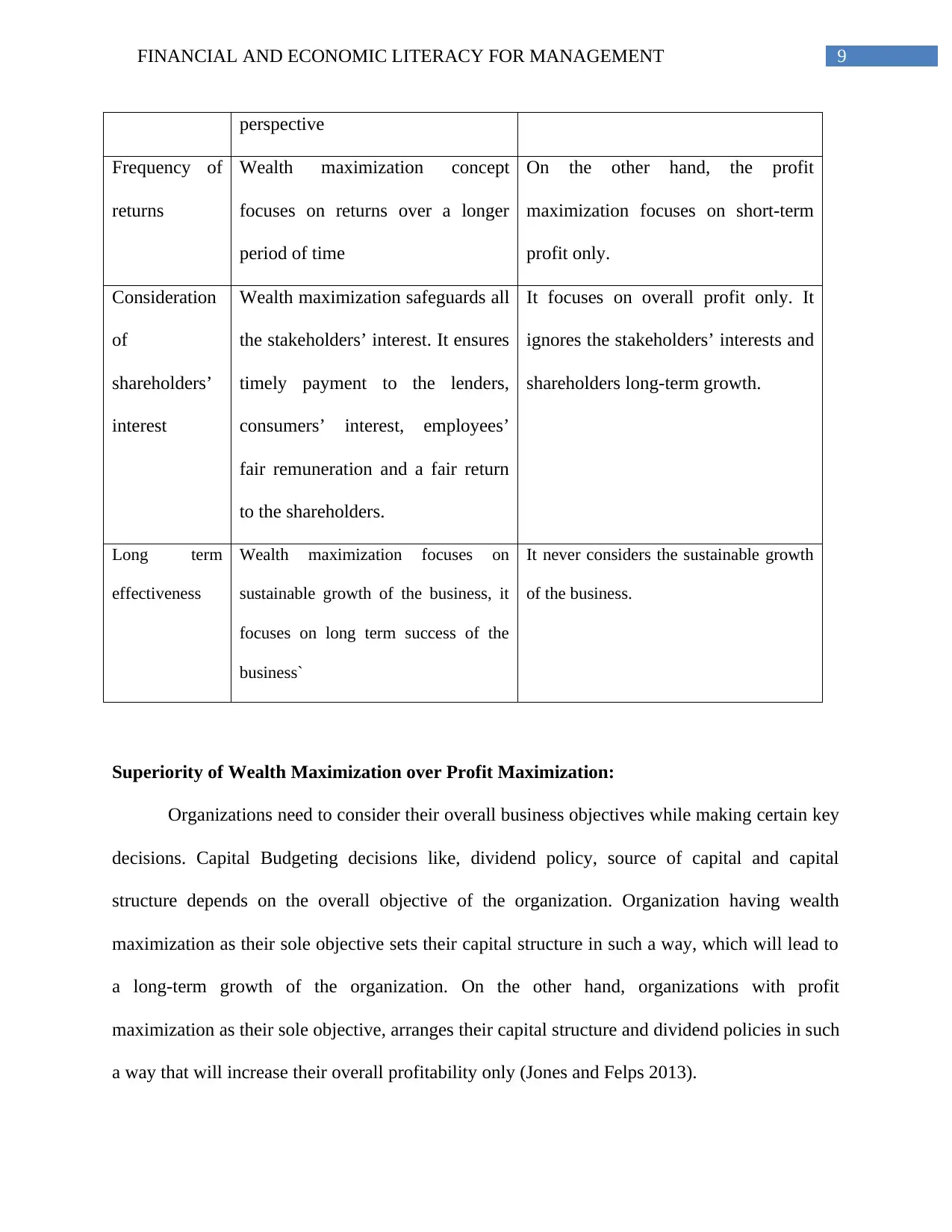
9FINANCIAL AND ECONOMIC LITERACY FOR MANAGEMENT
perspective
Frequency of
returns
Wealth maximization concept
focuses on returns over a longer
period of time
On the other hand, the profit
maximization focuses on short-term
profit only.
Consideration
of
shareholders’
interest
Wealth maximization safeguards all
the stakeholders’ interest. It ensures
timely payment to the lenders,
consumers’ interest, employees’
fair remuneration and a fair return
to the shareholders.
It focuses on overall profit only. It
ignores the stakeholders’ interests and
shareholders long-term growth.
Long term
effectiveness
Wealth maximization focuses on
sustainable growth of the business, it
focuses on long term success of the
business`
It never considers the sustainable growth
of the business.
Superiority of Wealth Maximization over Profit Maximization:
Organizations need to consider their overall business objectives while making certain key
decisions. Capital Budgeting decisions like, dividend policy, source of capital and capital
structure depends on the overall objective of the organization. Organization having wealth
maximization as their sole objective sets their capital structure in such a way, which will lead to
a long-term growth of the organization. On the other hand, organizations with profit
maximization as their sole objective, arranges their capital structure and dividend policies in such
a way that will increase their overall profitability only (Jones and Felps 2013).
perspective
Frequency of
returns
Wealth maximization concept
focuses on returns over a longer
period of time
On the other hand, the profit
maximization focuses on short-term
profit only.
Consideration
of
shareholders’
interest
Wealth maximization safeguards all
the stakeholders’ interest. It ensures
timely payment to the lenders,
consumers’ interest, employees’
fair remuneration and a fair return
to the shareholders.
It focuses on overall profit only. It
ignores the stakeholders’ interests and
shareholders long-term growth.
Long term
effectiveness
Wealth maximization focuses on
sustainable growth of the business, it
focuses on long term success of the
business`
It never considers the sustainable growth
of the business.
Superiority of Wealth Maximization over Profit Maximization:
Organizations need to consider their overall business objectives while making certain key
decisions. Capital Budgeting decisions like, dividend policy, source of capital and capital
structure depends on the overall objective of the organization. Organization having wealth
maximization as their sole objective sets their capital structure in such a way, which will lead to
a long-term growth of the organization. On the other hand, organizations with profit
maximization as their sole objective, arranges their capital structure and dividend policies in such
a way that will increase their overall profitability only (Jones and Felps 2013).
Paraphrase This Document
Need a fresh take? Get an instant paraphrase of this document with our AI Paraphraser
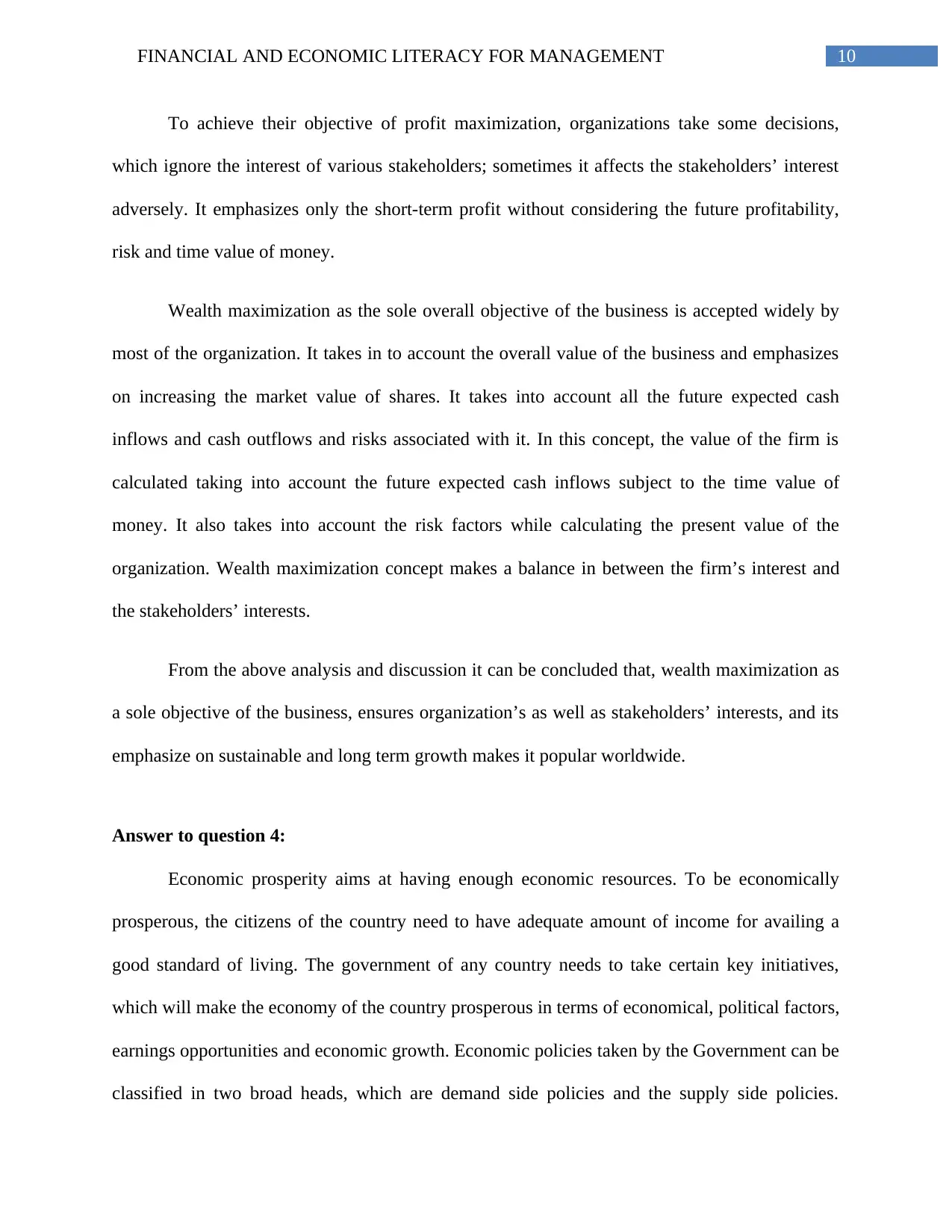
10FINANCIAL AND ECONOMIC LITERACY FOR MANAGEMENT
To achieve their objective of profit maximization, organizations take some decisions,
which ignore the interest of various stakeholders; sometimes it affects the stakeholders’ interest
adversely. It emphasizes only the short-term profit without considering the future profitability,
risk and time value of money.
Wealth maximization as the sole overall objective of the business is accepted widely by
most of the organization. It takes in to account the overall value of the business and emphasizes
on increasing the market value of shares. It takes into account all the future expected cash
inflows and cash outflows and risks associated with it. In this concept, the value of the firm is
calculated taking into account the future expected cash inflows subject to the time value of
money. It also takes into account the risk factors while calculating the present value of the
organization. Wealth maximization concept makes a balance in between the firm’s interest and
the stakeholders’ interests.
From the above analysis and discussion it can be concluded that, wealth maximization as
a sole objective of the business, ensures organization’s as well as stakeholders’ interests, and its
emphasize on sustainable and long term growth makes it popular worldwide.
Answer to question 4:
Economic prosperity aims at having enough economic resources. To be economically
prosperous, the citizens of the country need to have adequate amount of income for availing a
good standard of living. The government of any country needs to take certain key initiatives,
which will make the economy of the country prosperous in terms of economical, political factors,
earnings opportunities and economic growth. Economic policies taken by the Government can be
classified in two broad heads, which are demand side policies and the supply side policies.
To achieve their objective of profit maximization, organizations take some decisions,
which ignore the interest of various stakeholders; sometimes it affects the stakeholders’ interest
adversely. It emphasizes only the short-term profit without considering the future profitability,
risk and time value of money.
Wealth maximization as the sole overall objective of the business is accepted widely by
most of the organization. It takes in to account the overall value of the business and emphasizes
on increasing the market value of shares. It takes into account all the future expected cash
inflows and cash outflows and risks associated with it. In this concept, the value of the firm is
calculated taking into account the future expected cash inflows subject to the time value of
money. It also takes into account the risk factors while calculating the present value of the
organization. Wealth maximization concept makes a balance in between the firm’s interest and
the stakeholders’ interests.
From the above analysis and discussion it can be concluded that, wealth maximization as
a sole objective of the business, ensures organization’s as well as stakeholders’ interests, and its
emphasize on sustainable and long term growth makes it popular worldwide.
Answer to question 4:
Economic prosperity aims at having enough economic resources. To be economically
prosperous, the citizens of the country need to have adequate amount of income for availing a
good standard of living. The government of any country needs to take certain key initiatives,
which will make the economy of the country prosperous in terms of economical, political factors,
earnings opportunities and economic growth. Economic policies taken by the Government can be
classified in two broad heads, which are demand side policies and the supply side policies.
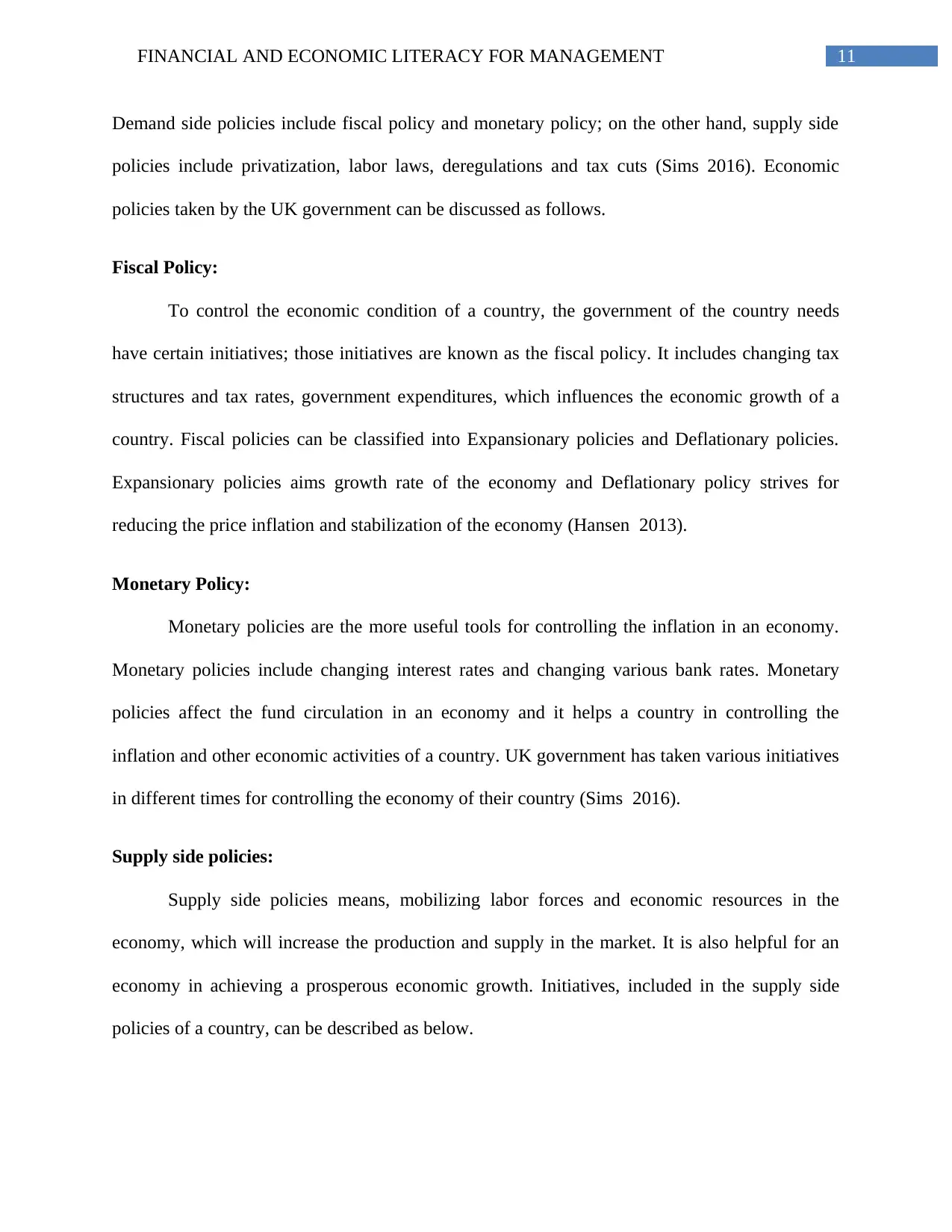
11FINANCIAL AND ECONOMIC LITERACY FOR MANAGEMENT
Demand side policies include fiscal policy and monetary policy; on the other hand, supply side
policies include privatization, labor laws, deregulations and tax cuts (Sims 2016). Economic
policies taken by the UK government can be discussed as follows.
Fiscal Policy:
To control the economic condition of a country, the government of the country needs
have certain initiatives; those initiatives are known as the fiscal policy. It includes changing tax
structures and tax rates, government expenditures, which influences the economic growth of a
country. Fiscal policies can be classified into Expansionary policies and Deflationary policies.
Expansionary policies aims growth rate of the economy and Deflationary policy strives for
reducing the price inflation and stabilization of the economy (Hansen 2013).
Monetary Policy:
Monetary policies are the more useful tools for controlling the inflation in an economy.
Monetary policies include changing interest rates and changing various bank rates. Monetary
policies affect the fund circulation in an economy and it helps a country in controlling the
inflation and other economic activities of a country. UK government has taken various initiatives
in different times for controlling the economy of their country (Sims 2016).
Supply side policies:
Supply side policies means, mobilizing labor forces and economic resources in the
economy, which will increase the production and supply in the market. It is also helpful for an
economy in achieving a prosperous economic growth. Initiatives, included in the supply side
policies of a country, can be described as below.
Demand side policies include fiscal policy and monetary policy; on the other hand, supply side
policies include privatization, labor laws, deregulations and tax cuts (Sims 2016). Economic
policies taken by the UK government can be discussed as follows.
Fiscal Policy:
To control the economic condition of a country, the government of the country needs
have certain initiatives; those initiatives are known as the fiscal policy. It includes changing tax
structures and tax rates, government expenditures, which influences the economic growth of a
country. Fiscal policies can be classified into Expansionary policies and Deflationary policies.
Expansionary policies aims growth rate of the economy and Deflationary policy strives for
reducing the price inflation and stabilization of the economy (Hansen 2013).
Monetary Policy:
Monetary policies are the more useful tools for controlling the inflation in an economy.
Monetary policies include changing interest rates and changing various bank rates. Monetary
policies affect the fund circulation in an economy and it helps a country in controlling the
inflation and other economic activities of a country. UK government has taken various initiatives
in different times for controlling the economy of their country (Sims 2016).
Supply side policies:
Supply side policies means, mobilizing labor forces and economic resources in the
economy, which will increase the production and supply in the market. It is also helpful for an
economy in achieving a prosperous economic growth. Initiatives, included in the supply side
policies of a country, can be described as below.
⊘ This is a preview!⊘
Do you want full access?
Subscribe today to unlock all pages.

Trusted by 1+ million students worldwide
1 out of 19
Related Documents
Your All-in-One AI-Powered Toolkit for Academic Success.
+13062052269
info@desklib.com
Available 24*7 on WhatsApp / Email
![[object Object]](/_next/static/media/star-bottom.7253800d.svg)
Unlock your academic potential
Copyright © 2020–2025 A2Z Services. All Rights Reserved. Developed and managed by ZUCOL.





